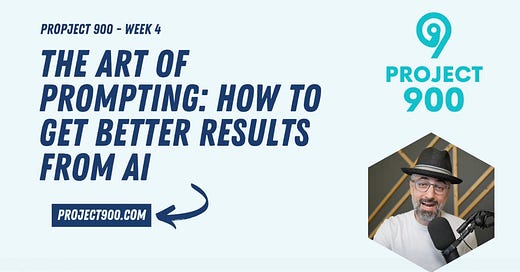Welcome to Week 4! So far, you’ve learned what AI is, explored basic tools, and gone deeper with features in ChatGPT and Gemini. Now it’s time for one of the most valuable skills you can learn: prompting.
Great prompts = great results.
This week, you’ll learn how to:
Structure your prompts using simple and complex formulas
Refine AI responses through back-and-forth
Ask AI to ask you questions
Practice with real nonprofit comms and fundraising examples
Let’s get into it.
The Anatomy of a Great Prompt
A prompt is just the instruction you give AI. But how you ask really matters. Here are three useful formulas:
Formula #1: Role + Task + Context + Constraints
"Act as a nonprofit communications manager. Write a 3-sentence Facebook post about our fall fundraiser. Make it inspiring and under 75 words."
Formula #2: Goal + Audience + Style
“Help me draft a thank-you email for monthly donors. Audience is warm and loyal. Keep it heartfelt and brief.”
Formula #3: Multi-Step + Clarifying Questions
This is the exact prompt I use to craft these lessons.
"You are a nonprofit professional educator with expertise in AI. Your mission is to make complex concepts easy to understand for nonprofit professionals, whether they’re completely new to AI or already using it daily.
For this prompt:
THIS WEEK = Week 4
Review the overall lesson plan and all past lessons that educate nonprofit professionals about AI. Follow these steps to refine and build out the lesson:
Step 1: Review and Clarify
- Carefully review the coursework outline attached for the context of the whole course.
- Review the specific outline for THIS WEEK.
- Ask clarifying questions if anything is unclear or missing.
- Suggest any changes that could improve the structure, flow, or clarity of the lesson.
STOP AND WAIT FOR MY FEEDBACK BEFORE PROCEEDING
Step 2: Draft the Lesson Materials
Based on the outline and feedback, create the following materials:
1. Lesson Title: A clear and engaging title that captures the essence of the lesson.
2. Short Description: A brief overview that explains what the lesson will cover and why it matters.
3. Detailed Lesson Outline: A comprehensive outline with clear definitions and explanations for any complex ideas.
4. Simplified Talking Points Outline: A streamlined version of the outline that can be used to create a video script or guide a live lesson.
5. Full Written Lesson: A detailed, standalone version of the lesson for learners who prefer reading.
6. Slide Show Overview: Create a slide show overview based on the outline. Include what content should be included in each slide. Keep it simple and straight forward.
Context and Constraints:
- Avoid jargon, buzzwords, and overly complex language. Use plain, conversational English.
- Avoid using all caps, excessive emojis, or heavy punctuation. Let the ideas shine naturally.
- Be bold and intriguing without resorting to clickbait or sensationalism.
- Your goal is to spark genuine curiosity and emotional resonance — not to manipulate or mislead.
When you are ready, ask me for the Lesson outline, and then follow the steps in this prompt."
Why it works: This kind of prompt gives AI multiple steps to follow, includes expectations, and encourages it to ask for clarification before starting — leading to better results.
Iteration: It’s a Conversation
You don't have to get the perfect response in one try. Prompting is a back-and-forth process. Try this:
Prompt: “Write a tweet about our food drive.”
Feedback: “Make it more upbeat.”
Feedback: “Add a call to action.”
Each round gets you closer to what you need. Don’t stop at one try.
Ask AI to Ask You Questions
Stuck? Don’t know what to say? Let AI guide you.
Try this:
"I want to write an event invitation, but I’m not sure how to start. Ask me 3 questions to help clarify what you need to know."
It’s like having a helpful coworker who pulls out the important details before they start writing.
Use Cases: Try These Prompts
Communications
“Act as a digital storyteller. Draft a Facebook post that announces our new mentoring program for teens. Keep it warm, conversational, and no more than 2 sentences.”
“Write a short, clear update email about our recent school supply drive success.”
Fundraising
“Help me draft a donor appeal for Giving Tuesday. Audience is current donors. Keep it emotional and focused on local impact.”
“Write a short, sincere thank-you for a first-time donor who gave $50.”
This Week’s Challenge:
Take a vague idea — something like “We need to get more people to our fall event.”
Then:
Use one of the formulas (including the multi-step version) to turn that into a strong prompt.
Get 3 different draft options from AI.
Pick one and refine it through two rounds of feedback.
Bonus: Ask AI to ask you questions first to sharpen the prompt.
Let’s make your prompts sharper, your outputs better, and your AI work even harder for you.
Join the Community:
If you haven’t already, join TheGoodCollective.US (supported by my friends at Green Mellen) to share your experiences on this AI journey for nonprofits!










Share this post